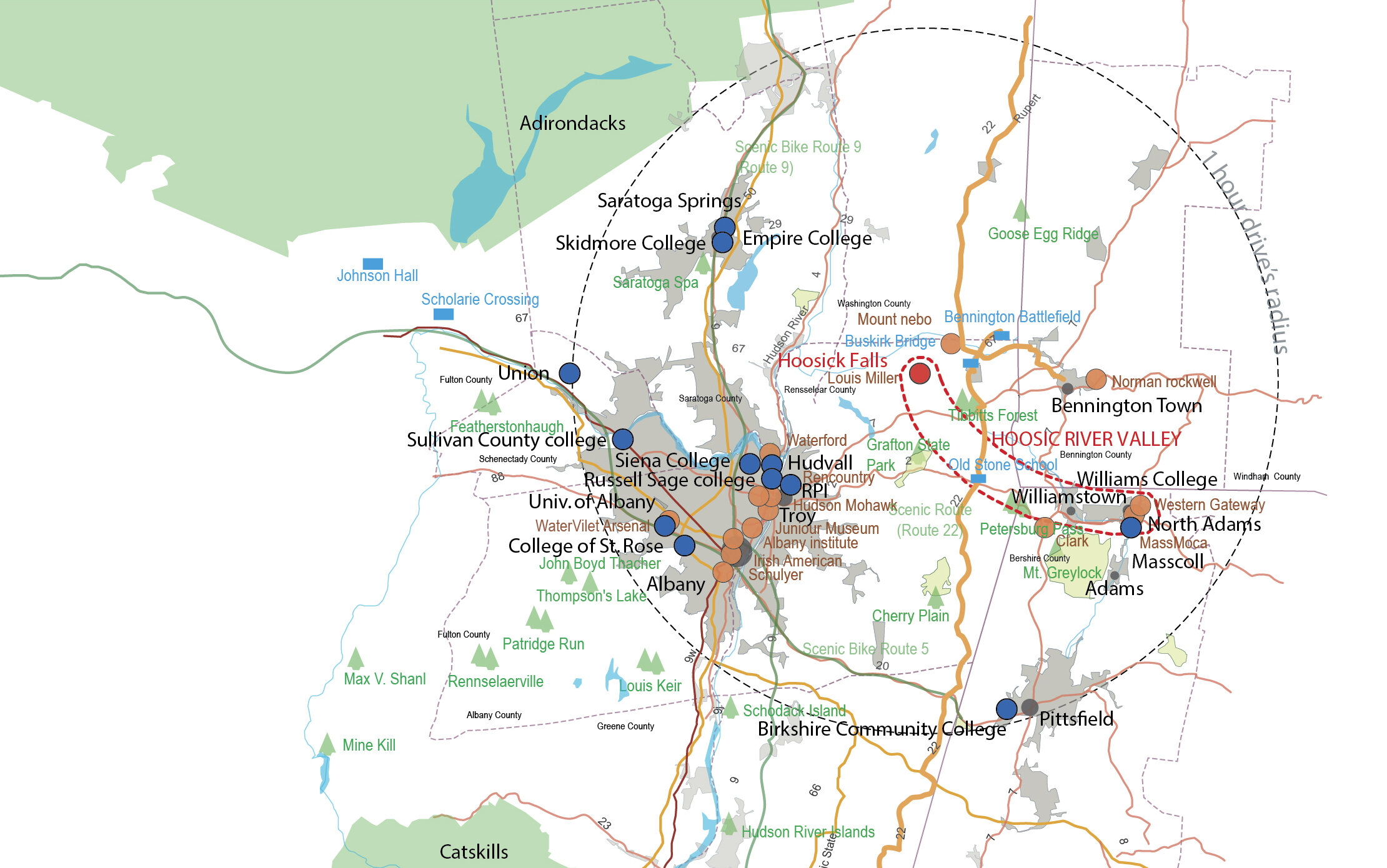Envisioning Hoosick Falls
Positioning for a Sustainable Future.
The Village of Hoosick Falls represents many of the small cities and towns in America today. Its formation during the industrial age, its loss of manufacturing and jobs when industry left, and the subsequent challenges it faces in positioning its future in the post-industrial context is a familiar story of transformation for many places like the Village of Hoosick Falls.
The Town of Hoosick is one of seven hamlets that make up the Greater Hoosick community located in rural northeast Rensselaer County. Greater Hoosick was settled in the early 18th century as an agricultural region. To this day, Hoosick still carries the long-tradition of farming due to the rich and fertile land nurtured by the rivers Walloomsac and Hoosick.
Manufacturing left Hoosick Falls steadily during the 20th century. By the 2000’s, very few manufacturing companies were in operation. In recent history-as recent as 2004-these plants closed or fractioned off, and taking many of the manufacturing jobs with them. Close-to-nil industry and low-employment depleted the resources; and it shows in the vacant buildings in the downtown. But as in the case of Hoosick Falls, there is a strong commitment to transforming their community, making it sustainable in the future.
There are a host of assets in the Village, and the Town, that can be harnessed for development, thus breathing life into a struggling economy and downtown. Areas for consideration in the revitalization efforts for Greater Hoosick are:
Agri-tourism: The combination of the bucolic landscape, the rivers and farms make for a scenario perfect for agri-tourism.
Local and Regional Infrastructure:The Village of Hoosick Falls is well connected to other assets in the region. The Town of Hoosick sits within the Hudson Valley Basin and the New York State’s Tech Valley.
Proximity to Cultural and Educational Poles: A vibrant, livable and affordable downtown could attract new residents and visitors from the adjacent economic/cultural centers.
Through community participation, assessment and feedback, the Design Team assisted the Village in envisioning a direction for physical and sustainable development of downtown Hoosick Falls.
The key areas identified in the Urban Design Plan are:
Downtown Node
The Central Business District (CBD) focuses on promoting and sustaining an active, economically-viable downtown that is pedestrian and parking-friendly. The downtown needs stores, restaurants and other activities and amenities that will attract and retain tourists. A Tourist Center is also needed to offer information about the Village’s visit-worthy sites. The CBD would also include a Business Improvement District (BID). The BID’s purpose is to create programs that would retain, attract and expand businesses in the downtown as well as offer a myriad of services to its members.
PROPOSED ARTS CULTURAL CENTER
The proposed arts/ cultural center serves two purposes. The first is as a public exhibition space for works of art; and the second is as a community center for Hoosick Falls.
Waterfront and Parks Development
The Hoosick River is a primary asset for the Village and the Town, and is far underutilized. Water pollution from the municipal sewage and long-term industrial waste affect its quality and uses. The Community Strategic Plan emphasizes the importance to promote public access to the river.
The Community Strategic Plan suggests preparing a riverfront corridor study that would document existing uses along the river, identify point and non-point sources of pollution, and investigate how to enhance the river and its edge for potential uses to enliven the community.
It is also suggested that the proper stewardship of the acres of parks, green spaces and the waterfront in the town be encouraged. Targeted green spaces include: Waterworks Park, Memorial Wood Park, the Golf Course and Country Club and the Hoosick River Greenway.
Recreational Node
The Recreational Development District (RDD) would create programs to promote tourism in all the parks and the greenway, museums, and buildings that contain community space, such as the Historical Society and the Hoosick Falls Fire Department.
The local economy is contingent upon on the success of the Central Business District, Recreational Development District, and the Waterfront Development. These projects will strengthen the Village’s identity and make the downtown more attractive to residents and visitors.
Location:
Hoosick Falls
Project:
Urban Design
Design Team:
Anthony Q. Crusor, Alessandro Cimini, Ignacio Lamar with Ira Jones-Cimini



